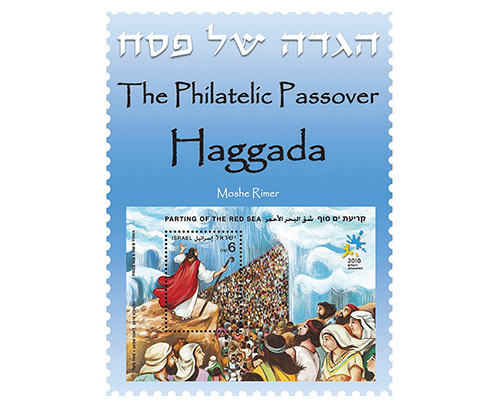

One of the main reasons we are commanded to partake in the Seder is to make sure children stay interested. Are you looking for a different kind of Haggadah that will keep the family interested? The Philatelic Passover Haggadah may be what you are seeking.
Whether or not you are a philatelist (stamp collector), the Philatelic Passover Haggadah can keep the conversation going with fascinating stories lavishly illustrated with postage stamps, envelopes sent through the mail, World War II soldiers’ postal services and more. You can learn how to read the name Ramesses, the Pharaoh most likely to have been ruling during the Jews’ escape from Egypt, in the original hieroglyphics. You can try to spot varieties of stamps while the children ask, “How is this different (Ma Nishtana)?” And before you fall asleep with bleary eyes, you can try out stamps with a “magic eye” theme.
Moshe Rimer, a member of the Israel Philatelic Federation, originally arranged and published the Haggadah in Hebrew in 2012. I recently updated some of the illustrations, added an English translation of the Haggadah and translated the philatelic commentary under the auspices of the Society of Israel Philatelists (SIP) of which I am a member. The SIP issued the book in 2018.
The English version maintains the beautiful typeface and illustrations of the original and includes instructions for conducting the Seder in Hebrew and English. The Haggadah remains easy and pleasant to use, with colorful stamps on nearly every page. The stories that accompany the stamps are interesting in their own right, while shedding light on passages from the Haggadah itself.
When the Jewish people are promised to leave Egypt after exile, the Haggadah quotes Bereishit 15:14, “and afterwards they shall leave with much property.” This provides an opportunity to depict the most valuable philatelic items in the world (pages 20-21). When Rabbi Yehuda makes an abbreviation out of the initial letters of the plagues, the book illustrates an attempt by a stamp designer to sneak his own initials into a stamp design (page 28). On the pages for Shulchan Orech, (the Pesach meal, pages 40-41), a stamp shaped like a banana from the Pacific Island of Tonga and a sheet of Swiss stamps that depict a chocolate bar are shown. The original Swiss stamps were printed with the aroma of chocolate embedded in the paper!
The book begins with an introduction that quotes the various places in Tanach where the holiday of Pesach is described. The full traditional text of the Haggadah follows in Hebrew and English, accompanied by the philatelic commentary. Following the Haggadah is the book of Shir HaShirim for those with the minhag to recite this megillah after the Seder. Stamps from areas throughout the world are shown, and various Israeli stamps are prominently featured.
Various explanations for the four cups of wine drawn from the Talmud, helpful explanations of some of the piyyutim at the end of the Seder (Nirtza) and much more can be found. The Haggadah will be a joy to use for years to some.
Anyone with a philatelist in the family, children with an interest in fun pictures, and adults all can find something to enjoy in this unique Haggadah. It can be ordered from the SIP website, israelstamps.com, under the “bookstore” tab, and it can be found until Pesach in several Teaneck Judaica stores and the Tenafly JCC gift shop.
By David Dubin
David Dubin, MD, is a graduate of the Albert Einstein College of Medicine of Yeshiva University, where he received his medical degree before completing a residency at St. Barnabas Medical Center in New Jersey. He has been practicing radiation oncology at Englewood Hospital and Medical Center for more than 27 years.











